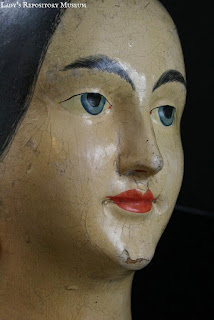c1840 German Mache Milliner's Model 531.2011.01
Boy last week has flown by~ its already time for another Museum Monday visit! This weeks number was 531~ an early papier mache Milliner's hat or wig stand, most often referred to as a Milliner's Model. She stands a stately 16" tall, and is in near mint condition, a joy to behold as many that survive have heavy facial damage, usually a missing nose, or have been repainted several times.
This scan is from Grafnitz's book, German Papier Mache Dolls 1760-1860, and shows a scan from a Sonneberg Germany sample book apx 1850 that shows both dolls and a larger milliner's head like our example. From studying her features and comparing with other known smaller dolls, I guestimate that she was made by either Muller or Kestner, with front hairstyle keeping with styles of smaller mache dolls in the early to mid 1840's.
She was made the same as the smaller mache head dolls, with layers of papier mache pressed into a sulphur mold. These molds were reused, and as so, the more they were used, the duller or softer the impressions they made became, as the molds wore down. Her features are so very crisp, and in looking at the inside features, I think she was one of the first out of her particular mold. These were made to sit on a hat or wig makers counter to display their newest creations, so to give them weight, a large opening is left in the back where a bag of sand could be placed within to keep her steady underneath an unbalanced hat
As we look closer, and in this view, if one didnt know she was a milliners model, she could be mistaken for an actual doll~she has the same detailed paint as large dolls of the period. Note that her outer varnish has not yellowed so we can appreciate the difference between her slight peachy flesh tone skin, and white part of her eyes
Brush strokes around the hairline of these early dolls/heads is a must~ if there are no shadowing brushstrokes, more likely than not the head has been repainted. Also note the fine cracklature of the original varnish~ all early mache dolls were varnished over the paint.
Careful brush stroke eyebrows show an artists pride in workmanship & skill
Looking up into her head, there are no repairs or identifying marks
But, looking closer, we can see her very crisp facial features, and that after removing her mould(s), her nose was filled in with mache, fingerprints still visible from its packing. Even in the period, the nose was recognized as these heads weakest point, so filling it in helped to keep it from denting or collapsing if the head fell over.
And not only do we have fingerprints on the inside, but at the nape of her neck as well, two fingerprints in the skin paint, under the varnish, most likely from the artist who painted her face
Who wouldn't want to buy whatever bonnet this pretty Ladye is wearing?











Ah HA ! So THAT's a real Milliner's model ! How fascinating to see the difference between her and the dolls ! The fingerprints make history come that much more alive. Thank you for sharing !
ReplyDelete